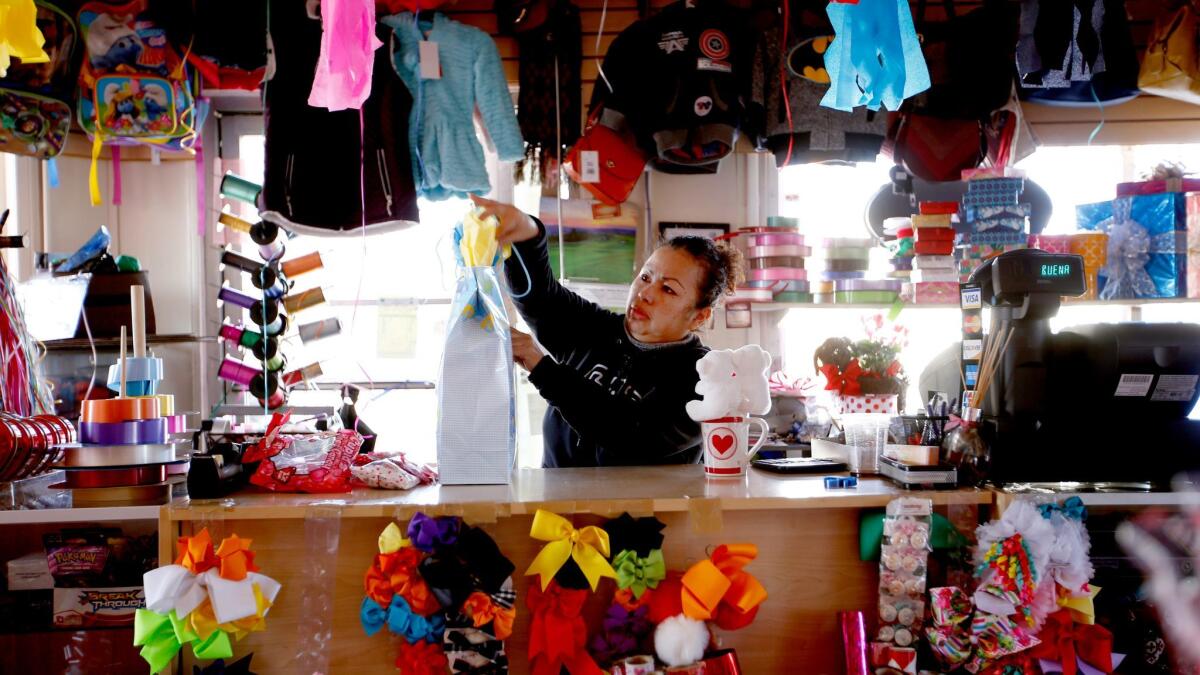Immigrants here illegally believe life is about to get a lot tougher
- Share via
Inside a Maywood laundromat, Hector Cruz waited amid the whir of spin cycles with his infant son. Although the 25-year-old arrived from Mexico without documents, he found a job at a car wash and feels safe within the tiny town that proclaimed itself a “sanctuary city” a decade ago.
Now the emergence of President Trump’s long-anticipated crackdown on illegal immigration has Cruz envisioning immigration raids, deportation, a fractured family.
Once places of refuge, so-called sanctuary cities have become targets, where residents worry that any concern for their welfare could be trounced by their community’s need for government funds.
But while anxiety and fear swirl in hundreds of cities across the nation that chose the largely symbolic designation — so too does defiance. In California, the forefront of the sanctuary movement, the mayors of San Francisco, Oakland, San Jose and Berkeley banded together and released a joint statement to decry the White House’s “morally bankrupt policies.”
Other leaders in the state have publicly declared they will continue offering protection for immigrants arriving illegally, disputed Trump’s capacity to cut off their access to federal purse strings, and even considered filing suit.
“Immigration issues belong to the federal government and to coerce and push a city to take on those responsibilities is 100% wrong,” said Sal Tinajero, a city councilman in Santa Ana, which voted unanimously to become a sanctuary city shortly after Trump was elected.
Tinajero said city leaders are prepared for possible funding cuts, adding that Santa Ana has more than $41 million in reserve, just in case.
“We’ll continue to move forward and stand in solidarity and send a strong message to the president of the United States and to our community,” he said. “We will not be using our police officers to work with the federal immigration system.”
Like Santa Ana, many of California’s sanctuary cities have large — if not overwhelming — Latino populations. Many have been for generations first stops for immigrants — here both legally and illegally — who have come to the United States from Latin America.
Inside Sheila’s flower shop in Cudahy, Olga Torres, 44, and Susan Flores, 45, watched Spanish-language TV news coverage about Trump’s crackdown.
Torres, who is in the country illegally, said she’s happy to be living in a sanctuary city like Cudahy, where her immigration status doesn’t seem to be a big deal. Now she fears that might all change.
“We’re worried. We don’t know what’s going to happen,” she said Wednesday. “It’s hard enough to find work without documents, and now I’m sure it’s going to be even harder.”
Flores said she empathizes with her friend.
“I spent three years without documents,” she said. “I know what it’s like to be walking around always in fear…. If you’re in this city, you’re fine, but if you go elsewhere, you don’t know what people’s attitudes are toward immigrants.”

Adopting sanctuary policies has been seen as a smart political move, especially in areas like Los Angeles County, where nearly 10 percent of the nation’s 11 million immigrants without legal status reside.
There is no neat definition of “sanctuary city,” but in general, cities that adopt the designation seek to offer political support or practical protections to people who are in the country illegally. For some cities, the sanctuary movement consists simply of encouraging people without legal status to get more involved in government. Other places, such as San Francisco, adopt far-reaching policies, such as taking steps to cut ties with federal immigration officials and refusing to fully cooperate with them.
Maywood declared itself a sanctuary 11 years ago, enacting a law that said local police could not enforce federal immigration law.
“We wanted our residents to know that we were there to support them,” said Veronica Guardado, a Maywood councilwoman at the time.
Guardado says Trump’s efforts make a troubling statement about America.
“Should we keep the Statue of Liberty or maybe take it down for a while?” she asked.
But supporters of Trump’s order say the plan to cut off funding to sanctuary cities was a long time coming.
“Money talks,” said Jessica Vaughan, director of policy studies at the Center for Immigration Studies, a Washington, D.C., think tank that advocates for restrictions on immigration. “But there probably will be some die-hards who will continue to play chicken on this, and they may face other consequences, such as litigation.”
Other anti-illegal immigration activists agreed, saying Trump is carrying out policies they have advocated for decades.
The policies have “finally put federal executive action on the side of the victims and potential victims of crime instead of protecting the interests of the businesses and organizations who profit from keeping as many illegal migrants in the country as possible,” said Roy H. Beck, who heads NumbersUSA, a powerful national advocacy group opposing illegal immigration.
As cities wait to understand how Trump’s order will play out, officials are scrambling to determine what it could mean if their funds are stripped. Los Angeles City Council members ordered advisors to report back on the definition of a sanctuary city and how it might apply to them.
Santa Ana recently decided not to allocate funds to some community programs in preparation for what might come. If budget funding is cut off, the city may consider banding together with others to file a lawsuit against the federal government. Cudahy has mulled over whether it could lose funds from a grant used for parks and public housing.
Towns like Maywood, which struggled with insolvency not long ago, have to consider their ability to function without federal help as well as residents who rely on their policies.
Los Angeles Mayor Eric Garcetti said Trump could be challenged by the 10th Amendment, which has been interpreted by the U.S Supreme Court to say the federal government cannot compel a local official to carry out a federal program.
“We feel very strong the legal case is clear,” Garcetti said Wednesday, hours after Trump signed the executive order seeking to withhold money from cities that don’t cooperate with immigration authorities.
Los Angeles will receive about $500 million this fiscal year from the federal government to pay for an array of services including port security, anti-gang programs and senior citizen services. That money doesn’t include federal funding that flows to entities such as the Los Angeles Unified School District or Los Angeles Homeless Services Authority.
Although Los Angeles follows policies similar to those in cities that trumpet themselves as a sanctuary city, leaders have skirted from a formal designation, with some preferring to use the term “welcoming.”
At Maywood Riverfront Park, immigrant residents said they feel that sense of welcome and hope it won’t change under Trump.
Maria Ruiz, 55, who divides her time between Mexico and Maywood, said she wants her city to maintain “sanctuary” status, even if that means losing federal funds.
“I support what they’re doing. The city will be fine. They’ll find a way to make up for the loss,” she said.
Hernan Hernandez, 51, of Compton said it’s one thing to carry out the law, and it’s another to punish an entire community.
“If the president wants to deport illegal immigrants, he can technically do that, and I have no issues with that,” he said. “But I find it to be a sad thing if he wants to withhold money from cities, because they’re entitled to it.”
ALSO
Trump versus California: The feud turns from rhetorical to real
No, California’s environmental laws probably won’t block Trump’s border wall
Trump administration moves make scientists nervous. Here’s what they’re planning to do about it
More to Read
Sign up for Essential California
The most important California stories and recommendations in your inbox every morning.
You may occasionally receive promotional content from the Los Angeles Times.

















